Classical Music

The season of classical music is coming! There are many classical performances held at the end of the year. have you ever thought about why we go to classical performances? That’s because we can enjoy the real sounds of musical instruments, and also see diverse interpretations of the music by various conductors. The more you learn about classical music, the more interesting it becomes! Here is some simple information that can help you enjoy the performances.
Various Forms of Classical Performances

Recital
Generally, there is only one performerand an accompanist. The audience can only focus on the performer.
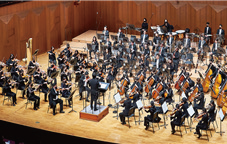
Orchestra
It is an ensemble composed of several instruments. These include wind, string, and percussion instruments.

Opera
There is music, acting, a stage setting and orchestral music. So, for this reason opera is often called “synthetic theatrical art”.
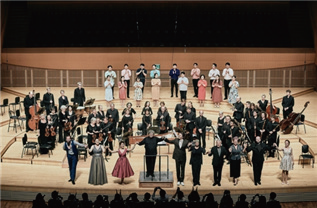
Opera Concertante (Concert Opera)
It is an opera in the form of a concert, conducted without stage equipment or costumes.
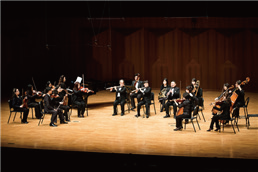
Chamber Orchestra
It is a small orchestra consisting of at least ten to as many as fi fty musicians . String instruments are mainly centered, and they can perform without a conductor.
How to Arrange Instruments
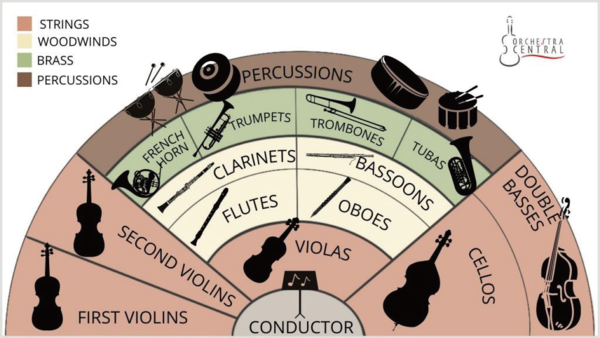
There is no fi xed method for the arrangement, and it changes depending on the song or the conductor’s preference. The most general method of arrangement is a Europe-style arrangement. It arranges the percussion, brass, woodwind, and string instruments from farthest to closest of the conductor, respectively. Lowpitched strings are positioned on the right side, while high-pitched ones are on the left. It pursues a spatial balance of the entire sound, by distributing the high-pitched and low-pitched string instruments evenly on the left and right sides, around the conductor. In addition, there are American-style placement methods and compromise-type placement methods too.
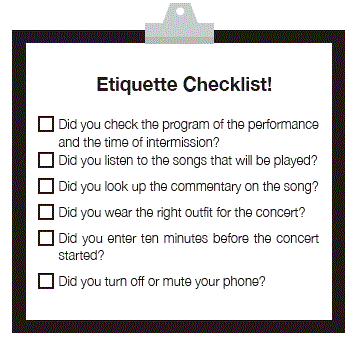
What is the right outfit?
Even if you don’t have a suit, you can wear casual clothing such as knitwear and jeans. However, you must abstain from indecent and impolite clothes such as shorts, miniskirts, and slippers. Wearing bulky clothes and thick strong perfume should be avoided as well.
Why do we have to check the program’s descriptions?
That's because familiarity is one of the best ways to appreciate classical music. The program’s pamphlet provides the order of the performances and intermission time. The composition descriptions contain various stories and interesting histories of the pieces. So, if you want to recognize songs and shout, "I know this song!" in your mind, it is better to look up the program and commentary-descriptions.
Manners during Classical Performances
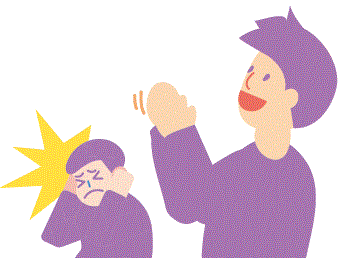
1. Clapping Issues
- Do not clap between movements. A classical piece is made up of several movements, and they flow as one. On the contrary, you should clap for every scene in a ballet or opera. The stage usually dims after a scene.
- Do not rush to clap after a piece is over. People do not attend classical performances to clap; they go to enjoy the music. Fully take in the character of the piece before appreciating the performance.
- It is never too late to clap after the conductor turns around to face the audience. There is no need to look at others for the right timing.
- Keep clapping even after the conductor walks off the stage. Clapping can be considered as positive feedback for a great performance.

2. Disturbing Others
- Do not move seats during a classical performance. Even if you spot a better seat, stay where you are; It is noisy, blocks the view of others, and breaks their concentration.
- Do not squeeze into your seat if you are late. Find an empty seat near the entrance and go to your seat during intermission.
- Be silent. Even the timed rests are part of a classical performance. Do not flip through the pamphlet or chat with your partner.
- Do not bang your head or tap your foot to the music. Try not to fidget either.
- Try not to bring children unless they have excellent manners. Always check if there is an age limit to the performance as well.

3. New Manners in COVID-19 era
- Be sure to wear a mask.
- Fill out any Covid-19 questionnaires before entering.
- Sign in with a QR code or complete the visit-record.
- Sit apart in order to minimize contact.
- Do not approach the performers, as gifts are also prohibited.
Tips from Experts to Enjoy Classics
For a better insight into classical performances, the following professionals kindly voiced their opinions: Violinist, Lee Jeong-a; conductor, Kang Jin-hak; and Jeonju Symphony Orchestra Librarian, Cho Kyu-chul.
Q : Why does the oboe tune the orchestra?
That is because the oboe’s unique tone is easy to hear. Unlike other instruments that are sensitive to humidity and temperature, only the oboe’s reed changes its pitch.
Q : Why does the conductor repeatedly exit and enter the stage?
A conductor walks in and out of the stage to change the atmosphere after a piece is over. Also, it is done to encourage additional applause from the audience, for the orchestra or soloist.
Q : Who is the violinist that shakes hands with the conductor?
It is the concertmaster. The concertmaster is the lead violinist that sits right next to the conductor’s podium. He or she acts as a bridge between the orchestra and the conductor and arranges the bowing of strings. By shaking hands with the concertmaster, the conductor shows appreciation to the entire orchestra.
Q : Do you have any advice for beginners?
Lee: Finding motivation is important. Instead of forcing yourself to go to classical performances, you should light-mindedly tag along with your family and friends. Go watch a classical performance after taking an interest in a certain piece or an instrument, even by chance!
Kang: You should keep in mind that every piece of classical music is telling a story. Classical performances can become boring in no time when the listener has no knowledge of it. I recommend that beginners look up the history of the pieces beforehand.
Cho: Studying classical music is necessary to understand it in depth. However, take baby steps. Start with looking up the names of familiar classical pieces from movies. Perhaps you think classical music is just not right for some people; remember, it just feels uncomfortable because of its unfamiliar format and name. Do not stress yourself out because there is no right and wrong in listening to music. You can just
appreciate the classical performance as it is and how it feels to your own ears and eyes.
The famous “Destiny Symphony” is named
Symphony No. 5 C minor, Op. 67
Composition type and number Key Opus number
Opus number chronologically lines up a composer’s pieces.
Q : Can you recommend any classical performancesfor beginners?
Jeollabuk-do Children’s Orchestra performs several times a year with easy and familiar pieces. In addition, year-end concerts are a great way to wrap up a year.

Sori Arts Center
Sori Arts Center of Jeollabuk-do is Jeonju’s main arts center with three concert halls: Moak, Myeongin, and Yeonji. People can see classical performances, musicals, plays, concerts, and more. Schedules for Jeonju’s classical performances can be found on the Sori Arts Center of Jeollabuk-do’s website.
Conclusion
You may find classical music to be boring and difficult to get into at first. However, if you enjoy it in your own way you will come to get more acquainted with it, and eventually appreciate it. Why don’t you give it a try, and go to a classical music concert at the end of this year?
Chin Da-youn, Park Ji-woo and Lee Da-yeon Reporters

